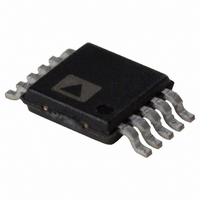AD8250ARMZ Analog Devices Inc, AD8250ARMZ Datasheet - Page 18

AD8250ARMZ
Manufacturer Part Number
AD8250ARMZ
Description
IC AMP INST ICMOS LDRIFT 10MSOP
Manufacturer
Analog Devices Inc
Series
iCMOS®r
Type
Instrumentation Amplifierr
Datasheet
1.AD8250-EVALZ.pdf
(24 pages)
Specifications of AD8250ARMZ
Amplifier Type
Instrumentation
Number Of Circuits
1
Output Type
Push-Pull
Slew Rate
25 V/µs
-3db Bandwidth
10MHz
Current - Input Bias
5nA
Voltage - Input Offset
70µV
Current - Supply
4.1mA
Current - Output / Channel
37mA
Voltage - Supply, Single/dual (±)
10 V ~ 30 V, ±5 V ~ 15 V
Operating Temperature
-40°C ~ 85°C
Mounting Type
Surface Mount
Package / Case
10-MSOP, Micro10™, 10-uMAX, 10-uSOP
No. Of Amplifiers
1
Gain Db Min
1dB
Gain Db Max
10dB
Bandwidth
10MHz
Amplifier Output
Single Ended
Cmrr
110dB
Supply Voltage Range
± 5V To ± 15V
Supply Current
4.1mA
Rohs Compliant
Yes
Number Of Channels
1
Number Of Elements
3
Power Supply Requirement
Dual
Common Mode Rejection Ratio
80dB
Voltage Gain Db
20dB
Input Bias Current
0.03@±15VnA
Single Supply Voltage (typ)
Not RequiredV
Dual Supply Voltage (typ)
±9/±12V
Rail/rail I/o Type
No
Single Supply Voltage (min)
Not RequiredV
Single Supply Voltage (max)
Not RequiredV
Dual Supply Voltage (min)
±5V
Dual Supply Voltage (max)
±15V
Operating Temp Range
-40C to 85C
Operating Temperature Classification
Industrial
Mounting
Surface Mount
Pin Count
10
Package Type
MSOP
For Use With
AD8250-EVALZ - BOARD EVALUATION AD8250
Lead Free Status / RoHS Status
Lead free / RoHS Compliant
Gain Bandwidth Product
-
Lead Free Status / Rohs Status
Compliant
Available stocks
Company
Part Number
Manufacturer
Quantity
Price
Company:
Part Number:
AD8250ARMZ
Manufacturer:
MICROCHIP
Quantity:
21 500
Part Number:
AD8250ARMZ
Manufacturer:
ADI/亚德诺
Quantity:
20 000
Part Number:
AD8250ARMZ-RL
Manufacturer:
ADI/亚德诺
Quantity:
20 000
AD8250
REFERENCE TERMINAL
The reference terminal, REF, is at one end of a 10 kΩ resistor
(see Figure 47). The instrumentation amplifier output is referenced
to the voltage on the REF terminal; this is useful when the output
signal needs to be offset to voltages other than its local analog
ground. For example, a voltage source can be tied to the REF
pin to level shift the output so that the AD8250 can interface
with a single-supply ADC. The allowable reference voltage
range is a function of the gain, common-mode input, and
supply voltages. The REF pin should not exceed either +V
or −V
For best performance, especially in cases where the output is
not measured with respect to the REF terminal, source imped-
ance to the REF terminal should be kept low because parasitic
resistance can adversely affect CMRR and gain accuracy.
COMMON-MODE INPUT VOLTAGE RANGE
The 3-op-amp architecture of the AD8250 applies gain and then
removes the common-mode voltage. Therefore, internal nodes
in the AD8250 experience a combination of both the gained
signal and the common-mode signal. This combined signal can be
limited by the voltage supplies even when the individual input and
output signals are not. Figure 27 and Figure 28 show the allowable
common-mode input voltage ranges for various output voltages,
supply voltages, and gains.
LAYOUT
Grounding
In mixed-signal circuits, low level analog signals need to be
isolated from the noisy digital environment. Designing with the
AD8250 is no exception. Its supply voltages are referenced to an
analog ground. Its digital circuit is referenced to a digital ground.
Although it is convenient to tie both grounds to a single ground
plane, the current traveling through the ground wires and PCB
can cause errors. Therefore, use separate analog and digital ground
planes. Analog and digital ground should meet at only one point:
star ground.
S
by more than 0.5 V.
V
REF
INCORRECT
AD8250
Figure 53. Driving the Reference Pin
V
REF
+
OP1177
–
CORRECT
AD8250
S
Rev. B | Page 18 of 24
The output voltage of the AD8250 develops with respect to the
potential on the reference terminal. Take care to tie REF to the
appropriate local analog ground or to connect it to a voltage that
is referenced to the local analog ground.
Coupling Noise
To prevent coupling noise onto the AD8250, do the following
guidelines:
•
•
•
•
•
•
Common-Mode Rejection
The AD8250 has high CMRR over frequency, giving it greater
immunity to disturbances, such as line noise and its associated
harmonics, in contrast to typical instrumentation amplifiers
whose CMRR falls off around 200 Hz. Typical instrumentation
amplifiers often need common-mode filters at their inputs to
compensate for this shortcoming. The AD8250 is able to reject
CMRR over a greater frequency range, reducing the need for
input common-mode filtering.
Careful board layout maximizes system performance. To
maintain high CMRR over frequency, lay out the input traces
symmetrically. Ensure that the traces maintain resistive and
capacitive balance; this holds for additional PCB metal layers
under the input pins and traces. Source resistance and capaci-
tance should be placed as close to the inputs as possible. Should a
trace cross the inputs (from another layer), route it perpendicular
to the input traces.
Do not run digital lines under the device.
Run the analog ground plane under the AD8250.
Shield fast switching signals with digital ground to avoid
radiating noise to other sections of the board, and never
run them near analog signal paths.
Avoid crossover of digital and analog signals.
Connect digital and analog ground at one point only
(typically under the ADC).
Use the large traces on power supply lines to ensure a low
impedance path. Decoupling is necessary; follow the
guidelines listed in the Power Supply Regulation and
Bypassing section.














